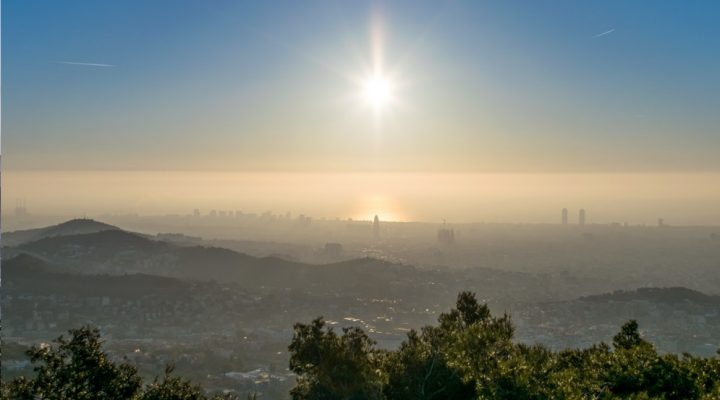EXACT AND NATURAL SCIENCES
Ocean halogens: key for the tropospheric ozone regulation
CONICET researcher participated in an international study which proved that natural halogens will have a fundamental role in the destruction of one of the existing contaminants in the lowest layer of the atmosphere.
The levels of tropospheric ozone during the 21st Century will be regulated by a source of natural buffer produced by halogenated compounds –organic and inorganic substances that contain chlorine, bromine and iodine –naturally emitted from the oceans through biotic and abiotic processes. This was the conclusion made by an international group of scientists in which Rafael Fernandez, CONICET associate researcher at the Instituto Interdisciplinario de Ciencias Básicas (ICB, CONICET-UNCuyo), participated.
Currently, natural halogens, which are normally not considered in the models of chemistry-climate, destroy between ten and twenty per cent of the total load of ozone that exists in the troposphere where it acts as a contaminant of the quality of the air –different from ozone that is in the stratosphere, beneficial for absorbing ultra violet radiation-.
“As regards atmospheric chemistry of halogens, most of climate studies exclusively consider the antropogenic sources because they affect directly the ozone layer in the stratosphere. However, the line of natural base in which the anthropic sources are added is very important at the time of evaluating the tropospheric ozone especially in a climate change context,” Fernández explains.
According to a recently published article in Nature Climate Change, the researchers reveal that the natural halogens have a strong capacity of regulation, what controls the load of tropospheric ozone as the global warming of the planet advances.
Climate simulations for period 1950-2100 were conducted using a CAM-Chem, Community Atmospheric Model with Chemistry, which was updated to include a complete representation of the chemistry of halogens. Compared with previous studies, the particularity of these simulations is that the changes in the emissions of natural halogens were connected to climate (temperature and wind) and biogeochemical (marine biological production) expected for the 21st century.
So they managed to determine a minimum and maximum range in the evolution of destructive power of tropospheric ozone that natural halogens will have in the future. The results show that the destruction of ozone mediated by halogens is highly heterogeneous with marked hemispheric, regional and vertical asymmetries. The study indicates that the losses of tropospheric ozone due to natural halogens towards the 21st century will be at least 70 per cent larger (compared to the present) in regions highly industrialized such as Southeast Asia or the East coast of the USA, with important benefits for the quality of air. Nevertheless, in the future, the capacity of destruction of the global tropospheric ozone, mediated by halogens, will be similar to the current one, mainly due to the buffering capacity generated by iodine emissions.
“In 2015 we proposed that there is an efficient mechanism of feedback in which an increase in the levels of the tropospheric ozone raises the iodine emissions, which at the same time act as a powerful destructor of the ozone that generates the emissions. In this new article we evaluate the impact of this natural feedback on the evolution of the levels of ozone during the 21st century, and we found that the iodine acts as a natural buffering that regulates the increase of ozone,” the researcher comments.
The authors of the study hope that these finds open the way to new research on the chemistry of natural halogens in the coming years, which regulate a significant fraction of tropospheric ozone in the present but due to expected climate changes will play a more and more leading role.
The study is part of project CLIMAHAL (“Climate dimension of natural halogens in the Earth system: Past, present, future”) financed by the European Research Council (program Consolidator Grant 2016 ERC, IP: Alfonso Saiz-López) and was led by the Instituto de Química-Física “Rocasolano” of the Consejo Superior de Investigaciones Científicas (CSIC) of Spain.
By Leonardo Fernández – CCT CONICET Mendoza
References
Iglesias-Suarez, F., Badia, A., Fernandez, R.P. et al. Natural halogens buffer tropospheric ozone in a changing climate. Nat. Clim. Chang. (2020). https://doi.org/10.1038/s41558-019-0675-6
About the study:
Rafael Fernández, Instituto Interdisciplinario de Ciencias Básicas (UNCuyo-CONICET) – Facultad de Ciencias Exactas y Naturales (FCEN-UNCuyo)
Fernando Iglesias-Suarez, Consejo Superior de Investigaciones Científicas (CSIC, España)
Alba Badia, Consejo Superior de Investigaciones Científicas (CSIC, España)
Carlos Alberto Cuevas, Consejo Superior de Investigaciones Científicas (CSIC, España)
Alfonso Saiz-Lopez, Consejo Superior de Investigaciones Científicas (CSIC, España)
Douglas E. Kinnison, National Center of Atmospheric Research (NCAR, Boulder, USA)
Simone Tilmes, National Center of Atmospheric Research (NCAR, Boulder, USA)
Jean-François Lamarque, National Center of Atmospheric Research (NCAR, Boulder, USA)
Matthew Long, National Center of Atmospheric Research (NCAR, Boulder, USA)
Ryan Hossaini, Universidad de Lancaster (UK)
